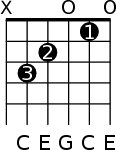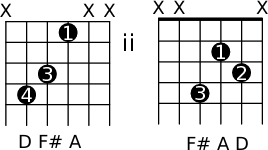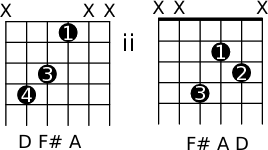 As players, guitarists are expected to have a wide range of skills including incredible ears. We are asked to play by ear, accompany singers in any key, and improvise. In developing these skills we need to be able to recognize different chord types and their inversions, as well as to be able to translate what we hear to the instrument.
As players, guitarists are expected to have a wide range of skills including incredible ears. We are asked to play by ear, accompany singers in any key, and improvise. In developing these skills we need to be able to recognize different chord types and their inversions, as well as to be able to translate what we hear to the instrument.
When we are learning different chord forms we seem to be inundated with their seemingly endless variations and notations. But at their essence are four different basic sound qualities: major, minor, diminished and augmented. Within these four basic triad qualities are really just two modes: major and minor. The diminished triad is related to the minor triad, as the augmented is to the major one.
In this article we will review close position major and minor triads as they are found on the guitar. Close position triads on the guitar are perhaps not the most practical chords to use from a playing perspective, but they will help you understand the construction of larger four and even six note chords that you may be more familiar with, and provide a means for learning their sound quality in their most basic forms.
Triads
Triads are three note chords built by stacking thirds, from a root note. If you consider the common C major chord below, it actually only consists of three pitches: C, E and G. The other two notes are just repetitions: another C on the second string and another E on the first string.

A standard C Major guitar chord
Chords sound the strongest when we put their root as the lowest note. Nevertheless, any of a chord’s members can be the lowest, note giving a triad three possible positions: root, first inversion, and second inversion, with the chord’s root, third and fifth respectively as the chord’s lowest note:

Three possible positions of a C Major triad: Root, first inversion, second inversion
The chord forms that we will be reviewing are in ‘close position’, that is to say, the notes will be packed together as closely as possible and without any repetition of pitches. The shapes will also be movable so that they can be transposed up and down the neck retaining their basic quality and position. Depending on your knowledge of different chord shapes, some will be familiar to you, some will not. Not to worry, for now think of these shapes as tools for developing your ear, rather than chords you should use in playing situations.
The following chord diagrams show the major triad form in root position built on different strings. The fingerings we use here are the most common ones:

Root position major triad shapes
Each of these forms are movable forms. For example, the first diagram shows an A major triad with the pitches A, C# and E. If you move the form up two frets (so your little finger is on the seventh fret rather than the fifth), the chord becomes an B major triad (B, D#, F#) and so on.
In the following exercise we play different major triads, moving the forms up the neck and on different string combinations. For each one, take your time to first arpeggiate through the chord (i.e. playing each note in turn from the lowers to the highest), then play it again in block form. Listen carefully to the sound quality between the chord’s root note and third, as well as the chord as a whole. If you do not know the names of these chords, not to worry. For this article, we are focusing on the sound of different types of triads.
Now let’s take a peek at minor chords in root position:
Compare the minor form with the major form. Notice that only the third of the chord is adjusted a fret lower.
We can practice playing root position minor triads as we did with major ones. Listen to the darker tone color of this kind of triad.
You can also compare major and minor chords side by side, paying attention to the smaller third of the minor triad and the difference in its sound quality.
When we compare the sound quality of major and minor triads, we can hear that the major chord has a brighter sound than the minor one. You will have undoubtedly realized that it must be the difference in the third of the chord which is responsible!
Inversions
First inversion triads have the third of the chord as the lowest note. Compare the following two chords.
The second chord has the same pitches as the first one, but the third of the chord is the lowest note, not the root note. In close position, the root actually moves to the highest position. Below are the basic shapes for first inversion triads on different strings. Listen to their sound quality and play each form in different positions on the guitar. Notice how their basic major or minor quality is retained.
First Inversion Major Triads:

First inversion major triad shapes
First Inversion Minor Triads:

First inversion minor triad shapes
Second inversion triads have the fifth of the chord as the lowest note. The fingerings suggested here facilitate comparing major and minor forms, although they are not the only options:
Second Inversion Major Triads:

Second inversion major triad shapes
Second Inversion Minor Triads:

Second inversion minor triad shapes
Conclusion
You may have discovered that with each of the basic chord qualities, once you understand the forms, you can actually arpeggiate through each of its positions quite easily on the guitar. This is a very useful way to listen to the different inversions of a particular chord in order. For example, the following tab arpeggiates through each of the inversions of a D major chord starting with its root on the fifth string:
Now that you have some experience with major and minor triads and their inversions in close position, you may be starting to see how they relate to many of the common guitar chord forms you already knew. This may be especially true if you practice the “CAGED system” of movable guitar chords.
Understanding and practicing the above chord forms will help you in learning to recognize them by ear. Take the time to play a particular chord shape in different positions on the guitar, both as block chords and as arpeggios. Compare these basic shapes with other chords that you are learning and take the time to consider their sound qualities as well.
Over time, the familiarity you build up with their basic shapes will transfer to you understanding their sound qualities as well. This kind of careful attention to the sound you make will also improve your technical facility as well as your overall musicianship.
See also:










